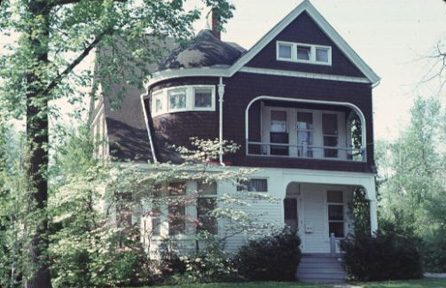Sweet House279 Elm, 1889 |

In 1889 several young members of the conservatory faculty bought lots toward the west end of Elm, in an area known as Hawley's orchard. Soon a cluster of new homes was going up, each house a variation on the popular Shingle Style of the day. None was more eye-catching than that built for Edgar G. Sweet, professor of pianoforte and singing. The house was constructed by contractor Charles Glenn, who was the busiest home builder in Oberlin toward the end of the century. Professor Sweet had a hand in the design, which melds a complex array of curved and angled shapes. The master bedroom under its squat tower, leading out to a second-story porch, was the decisive feature in a nicely managed composition. (The unusual round-cornered frames of this porch have been slightly altered since.) Some of the ideas built into the house look as if they might have [been] borrowed from Henry Hobson Richardson's influential 1883 Stoughton house in Cambridge, Massachusetts. In any event, it is perhaps the most innovative of Oberlin's homegrown contributions to the eclectic Queen Anne phase in American architecture.
For years the young conservatory crowd enlivened neighborhood social life with its Haphazard Club, named for the unscheduled geniality of its meetings. After World War I, with their two daughters grown and married, the Sweets built a new home still farther west on Elm, and sold the house at 279 to chemistry professor Alfred Lothrop. His son Richard grew up here, and in 1960 returned to live in his boyhood home.
(Blodgett 143-144)